Heart Shaped Cream Puffs
It doesn’t get much better than from-scratch cream puffs, especially filled with bavarian cream, drizzled in a decadent chocolate glaze.
I’ve never made cream puffs before because I’ve always been intimidated by what looked like a ton of work.
My husband finally convinced me to give them a go since they happen to be one of his favorite treats of all time, and I have to admit that the process wasn’t nearly as painful as I was expecting (actually most of the pain came from my 1-year old clinging to my legs the entire time and practicing cutting his two new teeth into my leg!).

A bit more work than a bar cookie, they really aren’t much more intense than doling out cookies on sheet pans to bake.
I made these babies heart-shaped since there is a certain holiday fast approaching that might have something to do with hearts.
Although the shape was a bit obscured once the pastries were filled with a thick and creamy homemade bavarian cream and drizzled in a simple but decadent chocolate glaze, the taste was unimaginable in it’s goodness.
Don’t be intimidated by The Cream Puff and the long recipe. I promise they are worth every minute (and calorie!) and come together a lot more quickly than it looks.
I’ve included pictures of my how-to below the recipe in case it helps.
By the way, here are a few other sweet delights that would make a great Valentine treat if you are still shopping around for ideas:
As for me, our Valentine’s dinner will be a tried-and-true recipe and for dessert, I’ll be making these, cutting them into heart shapes with a cookie cutter and topping with ice cream, hot fudge sauce, whipped cream and a sweet cherry.


Heart Shaped Cream Puffs
Ingredients
Pastry:
- 1 cup water
- 8 tablespoons (113 g) butter
- ¼ teaspoon salt
- 1 ¼ cups (178 g) all-purpose flour
- 4 large eggs
Bavarian Cream:
- 2 cups whole milk
- ½ teaspoon pure vanilla extract
- ¼ cup cornstarch
- ½ cup (106 g) granulated sugar
- ¼ teaspoon salt
- 2 large eggs
- 2 tablespoons (28 g) butter
- 1 ½ cups heavy cream
- ¼ cup (29 g) powdered sugar
- ½ teaspoon vanilla
Chocolate Glaze:
- 1 tablespoon (14 g) butter
- 1 ounce (28 g) (1 square) unsweetened baking chocolate
- 1 tablespoon hot water
- ½ cup (57 g) powdered sugar
Instructions
- For the bavarian cream, place the milk in a heavy-bottomed saucepan. Bring the milk to a boil over medium heat. Keeping an eye on the milk, whisk the cornstarch, sugar and salt together in a bowl. Gradually add the eggs and mix until smooth. Slowly add about one-third of the hot milk to the egg mixture while whisking rapidly (this is called tempering the eggs). Make sure to keep whisking quickly or the eggs will heat too quickly and develop lumpy spots. Pour the tempered egg mixture back into the remaining milk.
- Place the mixture over medium heat and cook, stirring constantly, until the mixture comes to a boil and thickens. Once thickened, boil for a few seconds longer to make sure the raw starch taste has disappeared (see Note below the recipe). Stir in the vanilla extract. Stir in the butter and continue to stir until it is completely incorporated.
- Pour the custard into a bowl and cover with a piece of saran wrap, pressing the wrap directly onto the surface of the custard and let cool completely at room temperature. When cooled completely, whip the heavy cream, powdered sugar, and vanilla to stiff peaks. Fold the whipped cream gently into the pastry cream. Again, press plastic wrap directly on the surface of the bavarian cream and store in the refrigerator. It will keep in the refrigerator for up to 4 days.
- Note: If the heat is too high or you are stirring too slowly at the point when the pastry cream reaches a boil, it may lump. If this happens, pass it through a strainer immediately, before it cools.
- For the cream puff pastry, preheat the oven to 425 degrees.
- Put the water, butter and salt in a saucepan and bring the mixture to a rolling boil. Remove it from the heat and add the flour all at once. Stir vigorously. Return the pan to the burner and cook over medium heat, stirring the entire time, until the mixture forms a ball; this should take only about a minute. When the dough has formed a ball and looks like this. (Photo #1 below)
- Remove the pan from the heat and let the mixture cool for about five to ten minutes. It will still feel hot, but you should be able to hold a finger in it for a few seconds.
- Transfer the dough to a mixer and beat in the eggs one at a time. This is how the mixture will look after the first egg is added. Don’t worry if the mixture kind of falls apart and looks crumbly. (Photo #2 below)
- It will come together as you keep adding the eggs. This is after adding the third egg and mixing. (Photo #3 below)
- Continue beating in the eggs one at a time until the mixture is light and fluffy. Continue beating for at least 2 minutes after adding the last egg. The mixture will look something like this. (Photo #4 below)
- The dough will be extremely sticky so don’t be alarmed if it is sticking to the beaters like there’s no tomorrow. Just scrape it back off into the bowl.
- Now you can form the choux paste into whatever shape you desire. Use a spoon to mound up balls of dough on a baking sheet or put the dough into a pastry bag and pipe it into a desired shape.
- I chose the pastry bag option. I fitted a pastry bag with my largest coupler (no tip) and piled the dough into the bag. And I mean piled. You can see that I may have overfilled the bag just a little. It was messy, very messy. So don’t make that same mistake, please. I’m assuming a large ziploc with a hole cut in the corner would help create a specific shape, also. (Photo #5 below)
- Pipe the dough onto a parchment or silpat lined baking sheet. I opted for simple “V” shapes for the hearts. You’ll notice there are ridges on the V’s. That’s a quick fix. (Photo #6 below)
- Simply wet your fingers and smooth down any ridges or bumps in the dough so the shapes are smooth. (Photo #7 below)
- Finally, bake the cream puffs for 15 minutes at 425 degrees and then reduce the temperature to 375 degrees and bake them for an additional 15 minutes. Turn off the oven, open the door a crack, and leave the pastry inside to cool for 30 minutes (if the pastries cool too quickly they will deflate). Remove them from the oven and cool completely before filling. The pastries should puff and brown beautifully while baking. (Photo #8 below)
- For the chocolate glaze, melt the butter with the chocolate in the microwave on 50% power. Once completely melted and smooth, stir in the hot water and sugar. Beat with a spoon or fork until the glaze is smooth and soft enough to pour. If the glaze is too thick, thin with hot water or cream.
- To assemble the cream puffs, carefully split open the pastry, fill it with a heaping amount of bavarian cream, replace the top and drizzle with the chocolate glaze. It is best to assemble these no longer than two hours in advance so the pastry doesn’t get soggy.
Recommended Products
Photo #1

Photo #2
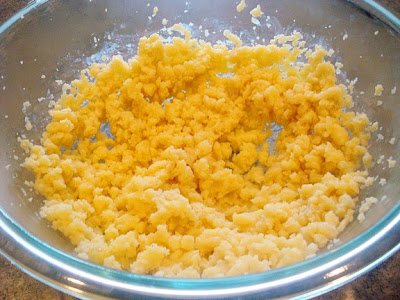
Photo #3
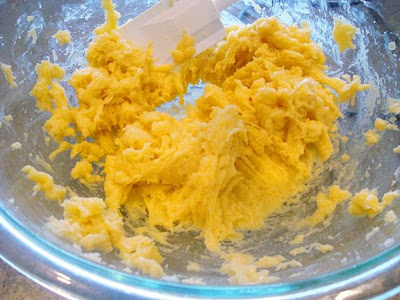
Photo #4

Photo #5
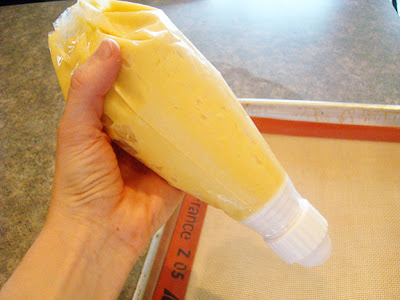
Here is a closeup of the coupler I used.

Photo #6
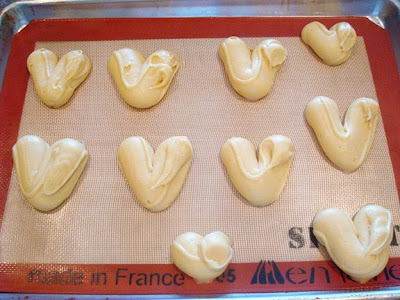
Photo #7

Photo #8

Recipe Source: Cream Puff Dough and Glaze from King Arthur Flour’s Baker’s Companion/Bavarian Cream adapted from The Professional Pastry Chef




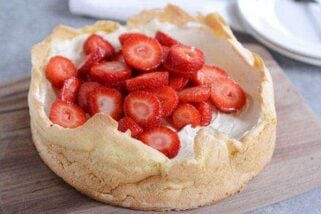

I enjoyed the cream but the dough for the puffs was way too thick for me to pipe out. They were also a little bit chewy. I would definitely use the cream recipe again though.
In honor of the Downton Abbey finale, we decided we needed a fancy treat. Yes, I know that the Downton folks are British and this dessert is French. Who cares– these were perfect. I mean really, really perfect. Knowing this Bavarian Cream exists may be my demise. They turned up absolutely beautiful and delicious to boot!
Melanie, Happy New Year and a prosperous one! The Cream puffs turned out so well!! Thanks for sharing your recipes. I had a little problem with “Bavarian Cream” had too much leftovers of the cream. What do you do with extra bavarian cream?
Thanks, Zoe! As for leftover Bavarian Cream – I usually either make extra cream puffs or serve it on top of waffles for a decadent breakfast.
I just had to pass along a tip I learned about cream puffs that made this process a lot faster and simpler: Bake them at 425 for 20 minutes, then poke a hole in the side of each puff. That allows the steam to escape so they won’t collapse. You don’t need to bake them any longer, and you don’t need to keep the oven door open or anything like that. Works like a charm. I just made over 100 of them for a huge luncheon, and didn’t have a single problem using that method! Hope that helps if you ever need to make multiple batches.
Love this tip, Reyna – thanks for sharing. And oh my, over 100 cream puffs? You are quite amazing.
I’ve done a little variation on these guys. I use the pastry recipe for the puffs from this post and the filling recipe from the Strawberry Cream Puff cake as the filling. Then instead of cutting the cream puffs in half, I pipe the cream into a little hole in the puff. Then, I can freeze those we don’t eat right after filling them and let some thaw when I’m hungry for a cream puff or two. 🙂
Adam B – ok, you are officially brilliant. LOVE this idea. Thanks for sharing!
I made the cream puff recipe and they turned out PERFECT!!! Thank you so much for sharing..your directions were so easy to follow. I made them a day a head for dessert. I mixed the cooked cream filling the day before and refrigerated it, the following day I wanted to serve them, I added the last three ingredients…The pastries stayed soft and fresh in an air tight container and refrigerated…I will make these many more times to come…!!! They were a big hit as dessert for my dinner.!!
Rebecca – just for the record, my hips and thighs aren’t thankful, either, but hey, it’s all about enjoying life, right?? Glad these cream puffs were a hit!
Hello. I just wanted to leave you a comment and let you know that I made these today for the whole extended family dinner. They gobbled them up!! They were so yummy and not as hard as I thought they would be. Thanks for posting all your yummy recipes and inspiring me to try things I normally wouldn’t (I am not sure my hips and thighs are as thankful 🙂 )
Hey Crystal, nice to meet you! 🙂 I hope Emily clued you in how NOT like a celebrity I am (you should see my toilets…celebrity toilets certainly don’t have rings around them like mine). Thanks for the comment!
Melanie! This is Crystal, Emily and I are new BFFs 🙂 You are seriously a celebrity in our house! The hearts are such a great idea! . I can’t wait to try your bavarian cream too. You are so wonderful! And you really do need to do a cookbook…..
Yum and what a pretty Silpat…love that Demarle!!! Great cookware!
What a wonderful Valentine’s Day treat! So perfect. I really need to start baking! Very inspiring blog.
Judy – so glad that you liked the chicken and dumpling soup!
I love cream puffs and haven’t had them for ages…oh my gosh those look so good.
Those look fantastic! What a great post! These have always been on my list of things to make. The heart shaped idea was great=)
Love the heart idea Melanie! I just posted my Eclair recipe on my blog a few days ago
http://thestainedapron.blogspot.com/2010/02/eclairs.html
awesome cream puff debut, melanie! not only are they perfectly puffy, but they just so happen to be in my favorite shape! bravo. 🙂
I used to make cream puffs in high school. These look like so much fun I added them to my weekend baking list.
Will make puffs another day but for Valentine’s will make your easy brownies with sauce/cream/and cherry – will serve under individual dome cake stands.
Made your Chicken and Dumplings Soup recently – my DH LOVES it and asked me to put it on our monthly meal docket – which I will definitely do. A keeper for sure.
Will make puffs another day but for Valentine’s will make your easy brownies with sauce/cream/and cherry – will serve under individual dome cake stands.
Made your Chicken and Dumplings Soup recently – my DH LOVES it and asked me to put it on our monthly meal docket – which I will definitely do. A keeper for sure.
Oh, these look so good! My mom used to make them. She shooed all 5 of us out of the kitchen so we wouldn’t make them fall after they’d baked. I will have to make some in memory of her. : )
Never thought to make the heart shape. You ought to try the chocolate mousse recipe that I put in some cream puffs a while ago. I think you’d love it.
Having just tried making cream puffs at home, with amazing success, I’m thrilled to see your heart shaped technique. Cuz everyone just needs another reason to whip up some cream puffs!
These cream puffs are a really adorable idea for V-day! And this is a spectacular recipe- I love a pastry cream in mine; so many use whipped cream. Ugh.